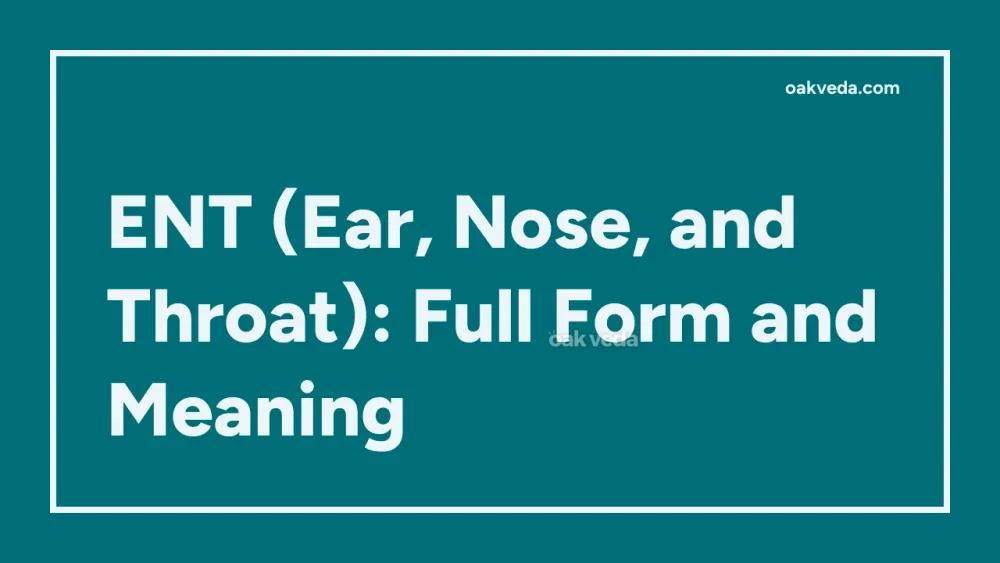
What is the Full Form of ENT?
The full form of ENT is Ear, Nose, and Throat. This abbreviation refers to a medical specialty that focuses on diagnosing and treating disorders related to these three interconnected areas of the human body. ENT is also known as otolaryngology, a term derived from the Greek words for ear (oto), larynx (laryngo), and nose (rhino).
What is Ear, Nose, and Throat (ENT)?
Ear, Nose, and Throat (ENT) is a branch of medicine that deals with the diagnosis, treatment, and management of diseases and disorders affecting the ears, nose, throat, and related structures of the head and neck. ENT specialists, also called otolaryngologists, are trained to handle a wide range of conditions, from common ailments like ear infections and sinusitis to more complex issues such as hearing loss and throat cancer.
Origin and Development of ENT
The field of ENT has a rich history dating back to the 19th century. It emerged as a distinct medical specialty in the 1920s when doctors began to recognize the interconnectedness of the ear, nose, and throat systems. Over the years, ENT has evolved significantly, incorporating advanced technologies and techniques to improve patient care and outcomes.
How does ENT work?
ENT specialists employ a variety of diagnostic tools and treatment methods to address issues related to the ear, nose, and throat. These may include:
- Physical examinations
- Endoscopic procedures
- Imaging studies (X-rays, CT scans, MRIs)
- Hearing tests
- Allergy testing
- Surgical interventions
ENT doctors work closely with other medical professionals, such as audiologists, speech therapists, and oncologists, to provide comprehensive care for their patients.
Types of ENT Subspecialties
While ENT is a specialized field in itself, it also encompasses several subspecialties:
- Otology/Neurotology: Focuses on ear disorders and related neurological issues
- Rhinology: Deals with nasal and sinus problems
- Laryngology: Specializes in voice and swallowing disorders
- Head and Neck Surgery: Addresses cancers and other conditions affecting the head and neck region
- Pediatric ENT: Concentrates on ENT issues in children
Functions of ENT
The primary functions of ENT include:
- Diagnosing and treating ear, nose, and throat disorders
- Performing surgical procedures when necessary
- Managing chronic conditions affecting the ENT system
- Providing preventive care and patient education
- Collaborating with other medical specialists for comprehensive patient care
Applications of ENT
ENT specialists treat a wide range of conditions, including:
- Hearing loss and balance disorders
- Chronic sinusitis and nasal obstruction
- Allergies and hay fever
- Tonsillitis and throat infections
- Voice and swallowing problems
- Sleep apnea and snoring
- Head and neck cancers
Features of ENT
Key features of the ENT specialty include:
- Comprehensive approach to interconnected systems
- Combination of medical and surgical expertise
- Use of advanced diagnostic technologies
- Focus on both acute and chronic conditions
- Emphasis on improving quality of life for patients
Benefits of ENT
The ENT specialty offers numerous benefits to patients, including:
- Specialized care for complex ear, nose, and throat issues
- Improved diagnosis and treatment of related conditions
- Enhanced quality of life through better hearing, breathing, and speaking
- Minimally invasive surgical options for many conditions
- Holistic approach to head and neck health
Limitations or Challenges of ENT
Despite its many advantages, ENT faces some challenges:
- Complex anatomy of the head and neck region
- Difficulty in accessing certain areas for examination and treatment
- Potential for complications in delicate surgical procedures
- Need for continuous education and training to keep up with technological advancements
- Balancing medical and surgical approaches to treatment
Future Developments in ENT Technology
The field of ENT continues to evolve, with exciting developments on the horizon:
- Robotic-assisted surgery for improved precision and outcomes
- Advanced imaging techniques for better diagnosis and treatment planning
- Gene therapy for hereditary hearing loss
- Personalized medicine approaches for allergies and other ENT conditions
- Artificial intelligence applications in diagnosis and treatment selection
FAQs on ENT Full Form
-
What does ENT stand for in medical terms? ENT stands for Ear, Nose, and Throat in medical terminology.
-
Is ENT the same as otolaryngology? Yes, ENT and otolaryngology refer to the same medical specialty.
-
What conditions do ENT doctors treat? ENT doctors treat a wide range of conditions affecting the ears, nose, throat, and related structures of the head and neck.
-
Do I need a referral to see an ENT specialist? In many cases, you may need a referral from your primary care physician to see an ENT specialist, but this can vary depending on your healthcare system and insurance requirements.
-
Can ENT doctors perform surgery? Yes, ENT doctors are trained to perform both medical and surgical treatments for conditions within their specialty.
In conclusion, the full form of ENT – Ear, Nose, and Throat – represents a vital medical specialty that addresses a wide range of conditions affecting these interconnected systems. As technology and medical knowledge continue to advance, ENT specialists will play an increasingly important role in improving the quality of life for patients with ear, nose, and throat disorders.
You may be interested in:

